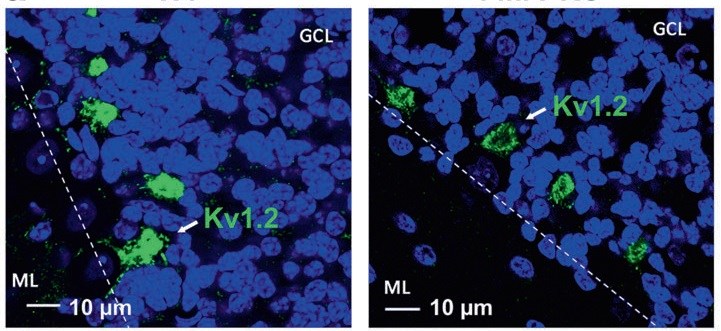Molecular site identified for targeted intervention of Fragile X syndrome
Summary:
Researchers at The Hospital for Sick Children (SickKids) have identified the ion channel known as Kv1.2 as a new target for reducing certain Fragile X syndrome (FXS) symptoms.
Researchers at The Hospital for Sick Children (SickKids) have identified the ion channel known as Kv1.2 as a new target for reducing certain Fragile X syndrome (FXS) symptoms. The research team, led by Dr. Lu-Yang Wang, Senior Scientist in Neurosciences & Mental Health at SickKids, found that these Kv1.2 channels are receptive to DHA, an omega-3 fatty acid commonly found in fish oils. The interaction between Kv1.2 and DHA has therapeutic potential for patients with FXS. Wang and co-authors, Drs. Yi-Mei Yang and Jason Arsenault published their findings in Molecular Psychiatry.
FXS is the most common type of genetic intellectual disorder, and shares some behavioural traits with Autism Spectrum Disorder (ASD). FXS symptoms include repetitive behaviour, intellectual disability, shyness, limited eye contact and memory problems. In some cases, FXS can also cause seizures. These symptoms are life-long and can range from mild to severe. FXS is caused when there are low levels of the Fragile Mental Retardation Protein (FMRP), which is a type of protein that is essential for cognitive development. The lab team found that DHA can compensate for lowered levels of FMRP in FXS. This could ultimately reduce certain Fragile X symptoms such as social interaction deficits.
This study focused on the cerebellum, an area of the brain that is often overlooked in ASD research. The cerebellum is a part of the brain that is largely responsible for motor movements, including several that are involved in social interaction such as eye contact and language. Low levels of FMRP cause excessive inhibition of neurons in the cerebellum.
Wang’s lab discovered that FMRP regulates the release of GABA neurotransmitters, which are responsible for making neurons less electrically excitable. FMRP regulates GABA release by directly interacting with the Kv1.2 ion channels, which are valves on the membranes of neurons that open and close to allow the passage of potassium ions. These channels regulate the excitability of nerve endings to control GABA release.
FXS patients have lower levels of FMRP, resulting in a decrease of Kv1.2 channels. This causes too much GABA to release, increasing inhibition in the brain. This is the first time this new FMRP function has been identified.

In addition to revealing a new function of FMRP, Wang’s lab discovered a compelling interaction between DHA and Kv1.2 ion channels. DHA is a fatty acid that is commonly found in omega-3 fish oils and is recommended as a supplement to support neurodevelopment. It was found to increase channel activity in Kv1.2 channels when FMRP levels are low. This inhibits GABA release and reverses behavioural deficits caused by low levels of FMRP. This interaction helps keep the neural networks of the brain balanced between inhibition and excitation.
“A majority of neurological and psychiatric disorders result from an imbalance of excitation and inhibition in the brain’s neural networks. This balance is really the yin and yang of the brain state,” says Wang, who is also a Professor in the Department of Physiology at the University of Toronto. “Excitation is important to keep the brain awake and attentive but too much can lead to seizures. Inhibition refers to the brain state being less active or sedated, for example during sleep or anaesthesia.”
This study shows why such an imbalance exists in the cerebellum of patients with FXS and how DHA, a nutritional supplement, has the potential to reinstate the balance by acting on Kv1.2.
The research identifies Kv1.2 as an entirely new molecular site that can be targeted by drugs or gene therapy in the future and the findings indicate the possibility of DHA being recommended for improving select FXS symptoms.
Wang’s team is now conducting a larger study to precisely determine the effects of DHA in animal models and screen for new drug candidates to target Kv1.2 channels. They are also looking to expand the scope of their study by using DHA supplements in the treatment of children with FXS.
This research was supported by the Canadian Institutes of Health Research, Canada Foundation for Innovation, start-up fund from University of Minnesota, the SickKids Centre for Brain & Mental Health “Chase an Idea” grant and the SickKids Foundation.
This is an example of how SickKids is making Ontario Healthier, Wealthier and Smarter.

